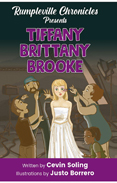
 |
Tiffany has big dreams. With her parents’ gift of a bus ticket to Los Angeles, Tiffany is taking the first step to becoming a prostitute. On the way, she meets a helpful older man who stresses the importance of following her dreams and not letting life get in the way. He tells her he always dreamed of becoming a serial killer, but marriage and children got in the way. When she arrives, she immediately sets out to find a pimp. However, she runs into a film agent instead. She doesn’t want to do something as sleazy as being an actress but takes his card, nonetheless.
After weeks of working the street without a single job or attracting the interest of a pimp, Tiffany breaks down and calls the agent. Several auditions later, even acting seems to have no place for Tiffany. She becomes increasingly worried that if any future Johns learn of her acting, they won’t want to be with her. Eventually, she numbs herself to acting and becomes a star because she is desperate for the money. After a while, Tiffany begins to like fame and adulation, but she is no longer able to hide the acting from her parents. Her parents are embarrassed and begin to suspect she has never even exchanged sexual favors for money. They travel to LA to save Tiffany from acting and take her back home.
Soling’s graphic novel is primarily a satire. Like Swift’s A Modest Proposal, which suggested the poor could sell their young to feed others, as well as giving advice on how best to serve these children, Soling plays on the convention of the actress who heads to Hollywood with big dreams only to end up desperate and broke and working the streets. A more contemporary example is found in Burroughs’ Naked Lunch with its outlandish solutions to human desires and the want to have control. However, Soling’s satire is not nearly as pointed or philosophical as either of these. Instead, he seems more interested in provoking a smirk or a bit of laughter with a head shake than trying to change the norms of society. The book targets an audience of readers who enjoy dark comedy, those who get a kick out of absurd situations and events that are meant to be funhouse mirrors held up against reality.
Listed as a graphic novel, the format is more like a picture book for children, although the content is definitely geared toward an adult audience. This could be a further attempt at enhancing the effect of the story’s absurd tale. The illustrations accurately depict the current action without breaking typical conventions. Soling’s writing is crisp, short on detail, and manages dialogue in a practiced and believable manner. This book is part of the author’s Rumpleville Chronicles, a series of short satirical works with deliberately shocking situations that use a wide variety of illustrators and art styles. Those who like the format and enjoy a satire wrapped in dark humor will probably find themselves seeking out more of Soling’s offerings.